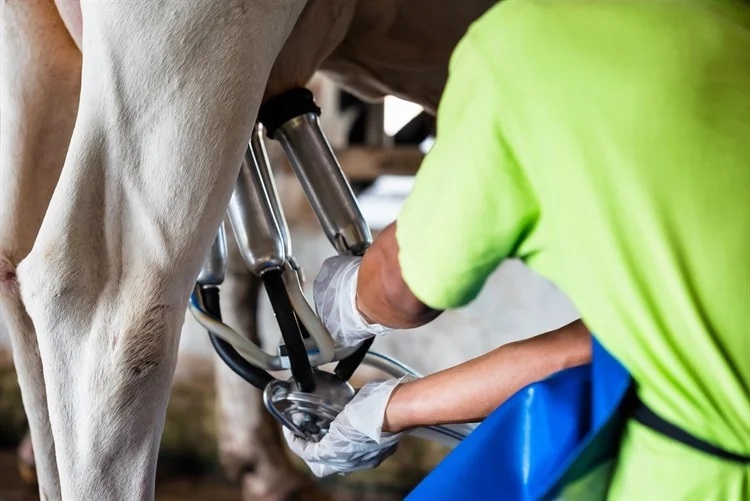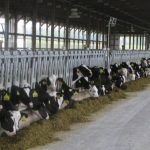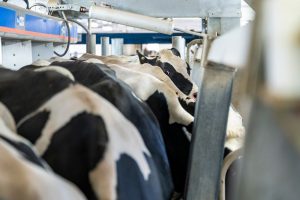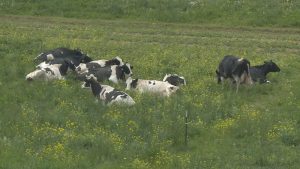
In a recent study published in the United States (U.S.) Centers for Disease Control and Prevention (CDC)’s Emerging Infectious Diseases Journal, researchers investigated the persistence of the highly pathogenic hemagglutinin 5 neuraminidase 1 (H5N1) avian influenza A virus from cattle and the H1N1 human influenza pdm09 pandemic virus strain in unpasteurized milk and on the surfaces of milking equipment.
 Research Letter: Persistence of Influenza H5N1 and H1N1 Viruses in Unpasteurized Milk on Milking Unit Surfaces. Image Credit: OULAILAX NAKHONE / Shutterstock
Research Letter: Persistence of Influenza H5N1 and H1N1 Viruses in Unpasteurized Milk on Milking Unit Surfaces. Image Credit: OULAILAX NAKHONE / Shutterstock
Background
The highly pathogenic H5N1 avian influenza A virus was detected in domestic cattle in March 2024, followed by the virus outbreak in large herds in numerous states in the U.S. and at least three confirmed infections in humans. Analysis of unpasteurized milk samples confirmed the presence of high virus levels in milk, suggesting that dairy workers exposed to unpasteurized milk were at a high risk of being infected by the H5N1 avian influenza virus.
Furthermore, an increase in the number of human infections of H5N1 could also give the virus opportunities to evolve and adapt to the human host, increasing the potential human-to-human transmission rates. Although the milking process in the dairy industry is largely automated, there are some stages where human inputs are required, which could increase the workers’ risk of exposure to the highly pathogenic H5N1 avian influenza A virus.
About the study
In the present study, the researchers analyzed whether the highly pathogenic H5N1 avian influenza A virus and the H1N1 human influenza pdm09 pandemic virus strain could persist in unpasteurized milk droplets on the surfaces made of stainless steel or rubber such as the ones found in milking units.
One of the steps during the milking processes where human input is required is forestripping, where the teats in the vacuum units are manually expressed for the first three to five streams of milk. This process removes bacteria and allows the workers to check for any abnormalities in the milk. However, it results in milk splatter on surrounding surfaces and exposes the workers to unpasteurized milk that could potentially contain the highly pathogenic H5N1 avian influenza A virus.
Milk splattering or spraying could also happen during other stages of the milking process. Furthermore, the workspace in which the dairy workers interact with the cows puts the human eye level closer to the cows’ lower regions, allowing droplets of potentially infectious milk to come in contact with the mucus membranes of the humans.
In this study, the researchers diluted strains of the highly pathogenic H5N1 avian influenza A virus or the surrogate H1N1 human influenza pdm09 pandemic virus strain in a 1:10 ratio using unpasteurized raw milk and pipetted droplets of this dilution onto rubber and stainless-steel surfaces inside an environmental chamber.
A tissue culture assay was used for endpoint titration to detect the presence of the virus at zero, one, three, and five hours. The experiments were conducted at 70% humidity to mimic the open-air environmental conditions in the milking parlors between March and April 2024 in the Texas panhandle region, which is when and where some of the outbreaks occurred.

Illustration of milking unit surfaces tested in a study of persistence of influenza H5N1 and H1N1 viruses in unpasteurized milk. Before attaching the milking unit (claw), a dairy worker disinfects the teat ends, performs forestripping of each teat to detect abnormal milk, and then wipes each teat with a clean dry towel. Workers then attach the milking unit to the cow teats. A pulsation system opens and closes the rubber inflation liner (at left) around the teat to massage it, mimicking a human stripping action. A vacuum pump is controlled by a variable speed drive and adjusts the suction to allow milk to flow down a pipeline away from the cow into a bulk tank or directly onto a truck. Additional sources of exposure to humans include handling of raw unpasteurized milk collected separately from sick cows or during the pasteurization process. Schematic created in BioRender (https://www.biorender.com).
Results
The study found that the highly pathogenic H5N1 avian influenza A persisted in the droplets of unpasteurized milk on the rubber and stainless-steel surfaces and remained infectious for over an hour. In comparison, the H1N1 human influenza pdm09 strain dropped below the detection limit in less than an hour.
However, the viral decay rates for the H5N1 and the H1N1 viruses were similar on stainless-steel and rubber surfaces, indicating that the H1N1 human influenza pdm09 strain could be used instead of the H5N1 cattle virus to study the persistence of the virus in raw milk samples.
Longer observational experiments indicated that the H1N1 pdm09 strain persisted on the rubber surface of the inflation liner used in the milking process for over three hours, while on the stainless-steel surfaces, it persisted in droplets of unpasteurized milk for at least an hour.
These results showed that the highly pathogenic H5N1 avian influenza A virus that has now infected domestic cattle can persist in unpasteurized milk and can remain infectious for over three hours inside droplets of milk splattered on surfaces during milking.
Currently, no respiratory or eye protection has been required for dairy workers, but the CDC has released recommendations for face shields, eye protection, masks, and other personal protective equipment. Sanitization of the rubber inflation liners is also recommended to prevent the spread of the virus among the cows.
Conclusions
To summarize, the recent outbreak of the highly pathogenic H5N1 avian influenza A virus among domestic cattle poses a serious risk of infection to dairy workers exposed to droplets of unpasteurized milk. The study found that the virus can persist and remain infectious in droplets of unpasteurized milk splattered on the surfaces of milking equipment for over three hours. The researchers recommend the use of protective equipment during milking and the sanitization of the milking equipment to prevent viral transmission among humans and animals.
- Sage, L., Campbell, A. J., Reed, D., Paul, D. W., & Lakdawala, S. (2024). Persistence of Influenza H5N1 and H1N1 Viruses in Unpasteurized Milk on Milking Unit Surfaces. Emerging Infectious Disease Journal, 30(8). DOI:10.3201/eid3008.240775, https://wwwnc.cdc.gov/eid/article/30/8/24-0775_article
You can now read the most important #news on #eDairyNews #Whatsapp channels!!!
🇺🇸 eDairy News INGLÊS: https://whatsapp.com/channel/0029VaKsjzGDTkJyIN6hcP1K























